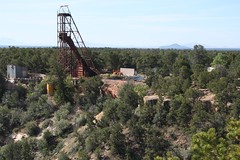
No More Uranium Here
Originally uploaded by cogdogblog
The abandoned uranium mine situated on the edge of the Grand Canyon (dubbed Orphan Mine) signals the end of one era and the possible beginning of another. The uranium mining frenzy and speculation that spread radioactive tailings, planted the seeds of cancer, and despoiled rivers and reserverations throughout the West seem likely to begin again, as discussed in Big Bad Boom by Chip Ward.
Ward paints a grim picture of the process:
So we in states like Utah, Nevada, Arizona, New Mexico, and Montana are poised for a mining boom reminiscent of the one in the 1950s when the nuclear age began. Then, the West’s uranium mines provided the raw material for our metastasizing Cold War nuclear arsenal and the nation’s first generation of nuclear reactors. (You remember Three Mile Island, don’t you?) Back then, radioactive ore was often dug out by impoverished Navajo miners desperate for jobs. Many of them later sickened and died from exposure to radioactivity.
After uranium has been turned into “yellowcake,” fit for further processing into reactor fuel, and then used to power a nuclear reactor, it is supposed to return to our Western landscapes in the form of “spent” nuclear fuel — something that is lethally dangerous for tens of thousands of years. Our arid landscapes, we are told, are ideal for waste that must be kept isolated and dry for at least a thousand years.
In other words, we get it at both ends of the nuclear energy cycle — and the drier we get, the more appealing we look. First, they dig a hole and take it out; then, they dig another and return it to the ground in far more dangerous shape. Lurking between the mines and the waste dumps are processing mills — and, of course, we have them, too. Even as debris from toxic slag piles in the old mines and mills of the West is still blowing in the wind or leaching into our watersheds, new slag heaps are taking shape in the fevered dreams of the next generation of speculators.
With abundant renewable energy sources ready to meet our national requirements, there is no good reason to resurrect radioactive ghosts from the failures of the past.